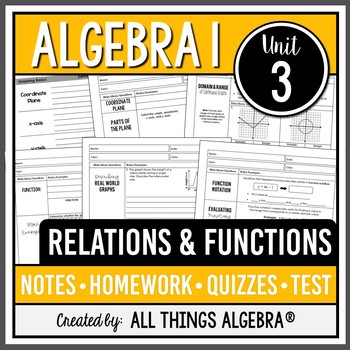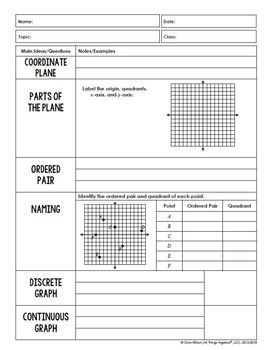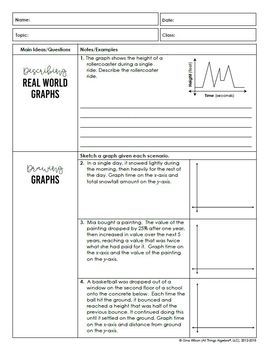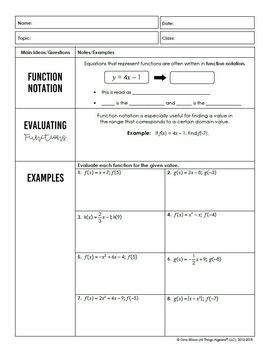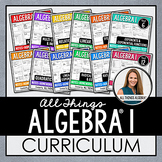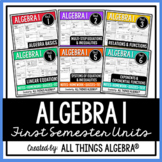Relations and Functions (Algebra 1 Curriculum - Unit 3) | All Things Algebra®
- Zip
- Google Apps™

What educators are saying
Also included in
- All Things Algebra 1 CurriculumWhat does this curriculum contain? This curriculum includes 900+ pages of instructional materials (warm-ups, notes, homework, quizzes, unit tests, review materials, a midterm exam, a final exam, and many other extras) for Algebra 1. All answer keys are included. ThiPrice $160.00Original Price $277.45Save $117.45
- Algebra 1 (First Semester) - Notes, Homework, Quizzes, TestsThis bundle contains the following units:• Algebra Basics• Multi-Step Equations & Inequalities• Relations & Functions• Linear Equations• Direct and Inverse Variation• Systems of Equations & Inequalities• Exponents & ExponentPrice $71.20Original Price $111.75Save $40.55
Description
This Relations and Functions Unit Bundle contains guided notes, homework assignments, two quizzes, a study guide, and a unit test that cover the following topics:
• Coordinate Plane and Graphing Review
• Relations
• Representing Relations (Tables, Graphs, Ordered Pairs, Mappings)
• Domain and Range of Ordered Pairs
• Domain and Range of Continuous Graphs
• Relations vs. Functions, Vertical Line Test
• Real World Graphs
• Equations as Functions
• Graphing Functions by Table
• Function Notation
• Evaluating Functions
• Zeros of Functions
• Writing Description of Graphs
• Arithmetic Sequences
Please download the preview to see a sample outline along with a collage of some of the pages.
ADDITIONAL COMPONENTS INCLUDED:
(1) Links to Instructional Videos: Links to videos of each lesson in the unit are included. Videos were created by fellow teachers for their students using the guided notes and shared in March 2020 when schools closed with no notice. Please watch through first before sharing with your students. Many teachers still use these in emergency substitute situations.
(2) Editable Assessments: Editable versions of each quiz and the unit test are included. PowerPoint is required to edit these files. Individual problems can be changed to create multiple versions of the assessment. The layout of the assessment itself is not editable. If your Equation Editor is incompatible with mine (I use MathType), simply delete my equation and insert your own.
(3) Google Slides Version of the PDF: The second page of the Video links document contains a link to a Google Slides version of the PDF. Each page is set to the background in Google Slides. There are no text boxes; this is the PDF in Google Slides. I am unable to do text boxes at this time but hope this saves you a step if you wish to use it in Slides instead!
This resource is included in the following bundle(s):
Algebra 1 First Semester Notes Bundle
Algebra 1 Curriculum
Algebra 1 Curriculum (with Activities)
More Algebra 1 Units:
Unit 2 – Multi-Step Equations & Inequalities
Direct & Inverse Variation (Mini-Unit)
Unit 5 – Systems of Equations & Inequalities
Unit 6 – Exponents and Exponential Functions
Unit 7 – Polynomials & Factoring
Unit 9 – Linear, Quadratic, and Exponential Functions
Unit 10 – Radical Expressions & Equations
Unit 11 – Rational Expressions & Equations
LICENSING TERMS: This purchase includes a license for one teacher only for personal use in their classroom. Licenses are non-transferable, meaning they can not be passed from one teacher to another. No part of this resource is to be shared with colleagues or used by an entire grade level, school, or district without purchasing the proper number of licenses. If you are a coach, principal, or district interested in transferable licenses to accommodate yearly staff changes, please contact me for a quote at allthingsalgebra@gmail.com.
COPYRIGHT TERMS: This resource may not be uploaded to the internet in any form, including classroom/personal websites or network drives, unless the site is password protected and can only be accessed by students.
© All Things Algebra (Gina Wilson), 2012-present

